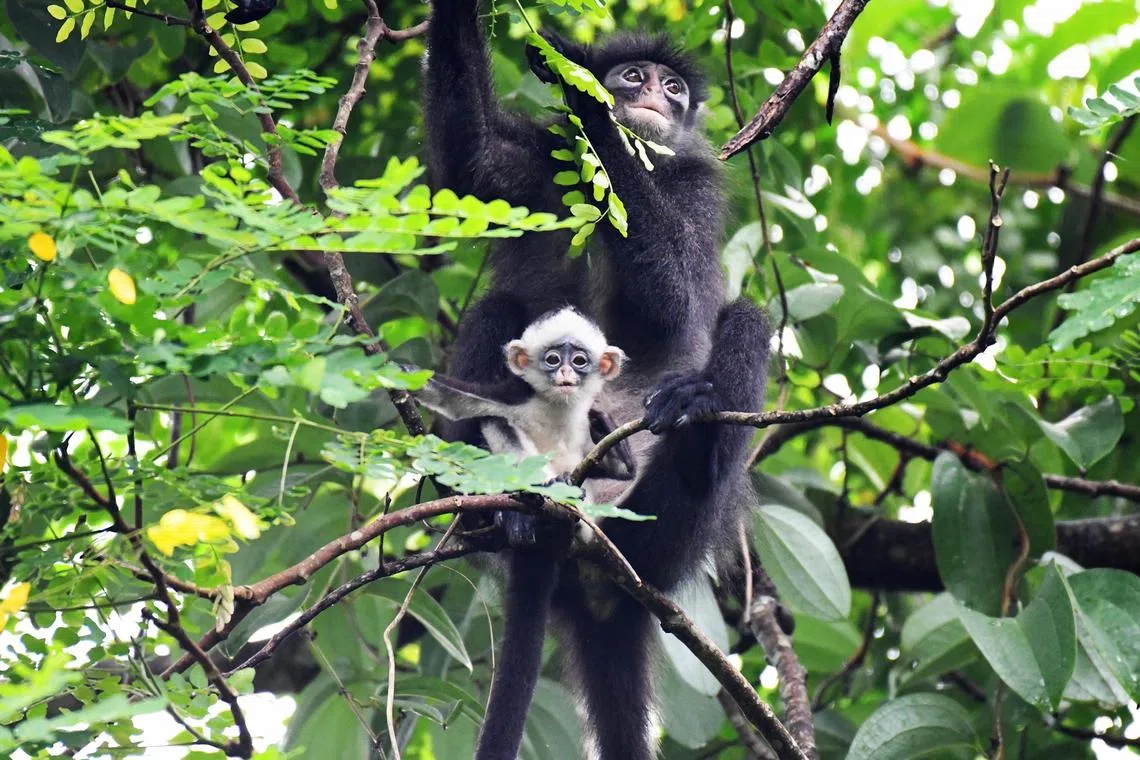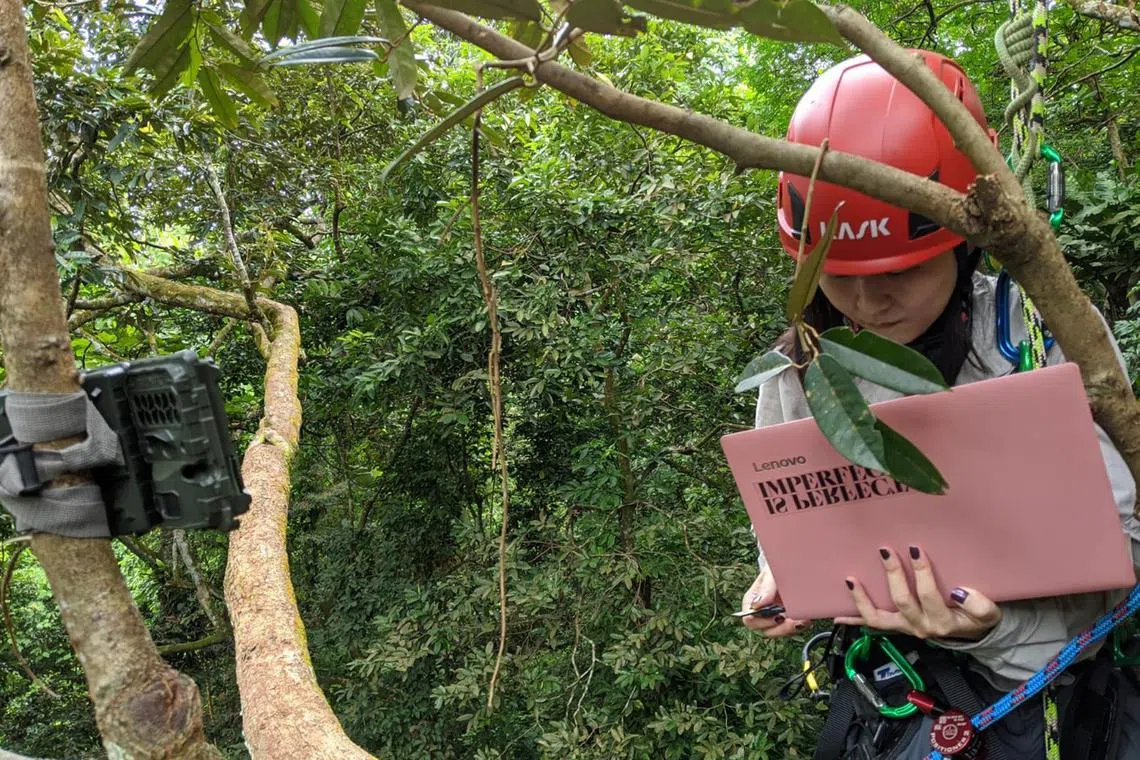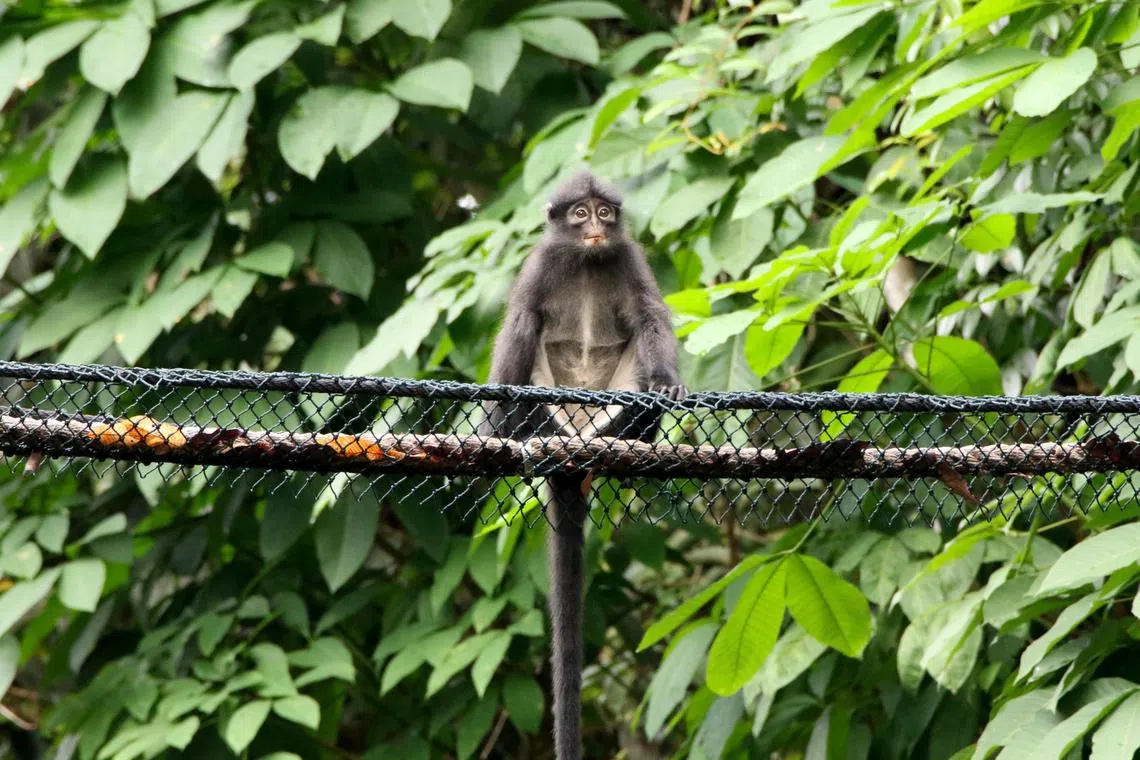Once nearly extinct, rare Raffles’ banded langur numbers in Singapore set to double to 150 by 2038
Sign up now: Get ST's newsletters delivered to your inbox

A Raffles' banded langur and her baby. The population of the species in Singapore is likely to more than double in the next 15 years, thanks to conservation efforts.
PHOTO: ANDIE ANG
Follow topic:
SINGAPORE – The rare Raffles’ banded langur is slowly bouncing back from the brink of extinction, and its numbers are likely to double from 75 to more than 150 in Singapore in the next 15 years, said experts.
The shy, tree-dwelling monkey – found only in Singapore and southern Peninsular Malaysia – was in the 1990s predicted to die out within 40 years because of habitat loss and fragmentation, said Mandai Nature and Oxford Brookes University in a joint statement on Tuesday.
Mandai Nature is the conservation arm of the Mandai Wildlife Group, and Oxford Brookes is a British university whose researchers teamed up with their counterparts in Singapore for the study.
The number of Raffles’ banded langurs – distinguished from common long-tailed macaques by their black fur and white bands – hit a low of 10 in Singapore in the 1980s, but has slowly been climbing in recent years, the statement added.
A study published in the Raffles Bulletin Of Zoology journal in September found that the population of the langur, which is Singapore’s largest primate species in the wild, is expected to go up to more than 240 by 2071.
Primate expert Andie Ang, who is one of the authors of the study, said: “The results presented in our paper show that with the right protection and management measures in place, we can bring a species back from the brink of extinction.
“However, these endeavours demand steadfast dedication in the field, strong partner collaborations and adequate financial support.”
Dr Ang helms the Raffles’ Banded Langur Working Group, which was formed in 2016 to drive efforts to conserve the elusive animal. She said it remains one of the most threatened primates in the world.
Despite the optimistic projections in the latest study, the researchers said even a small uptick in deaths can be damaging for the population of Raffles’ banded langurs in Singapore.
In the statement, Ms Amy Woolloff, the lead author of the paper, said: “Although our model shows the population is likely to continue growing in the next 50 years, they remain vulnerable to not only deaths from roadkill, but also unpredictable events such as diseases and extreme weather.”
Between 2017 and 2023, four langurs, or about 5 per cent of the total population in Singapore, died in road accidents.
Ms Woolloff said: “To ensure the long-term survival of this species in Singapore, there remains an urgent need to identify more suitable habitats for the Raffles’ banded langurs, to enhance habitat connectivity to prevent deaths occurring from road crossings, and to increase population genetic diversity with conservation translocation.”
Where these langurs are concerned, conservation translocation would involve introducing individuals of the species from Malaysia to Singapore to mix and breed with those here.

Primate expert Andie Ang installing a camera in the Central Catchment Nature Reserve to monitor the langur populations.
PHOTO: ANDIE ANG
Researchers found that the loss of unprotected habitat is the greatest threat now, while the most effective short-term management strategy is to improve links between patches of forest areas in the langurs’ current range.
Speaking to The Straits Times, Dr Ang said one high-priority site is the forest opposite Thomson Nature Park, close to the spot where two Raffles’ banded langurs were killed on the Seletar Expressway in late 2022.
The site is slated for residential development, according to the Urban Redevelopment Authority’s 2019 masterplan.
Mr Lim Liang Jim, who is the National Parks Board’s (NParks) group director of conservation, said the board has been taking steps to protect and shore up key habitats for the langur.

A Raffles’ banded langur on one of the rope bridges installed by the National Parks Board to facilitate crossings between fragmented forest habitats.
PHOTO: SABRINA JABBAR
These include planting trees that have spreading canopies, and installing rope bridges to allow the animals to cross between forest areas safely.
Mr Lim said: “In assessing where to situate the rope bridges, NParks worked closely with the Raffles’ Banded Langur Working Group to locate them where the langurs have been observed to habitually cross. NParks will continue to work with the community to come up with strategies to strengthen the survival of our native langurs and other wildlife.”
The Raffles’ Banded Langur Working Group is managed and funded by Mandai Nature, and its members include representatives from NParks, Singapore universities, nature groups, agencies in Malaysia and the Jane Goodall Institute (Singapore).


